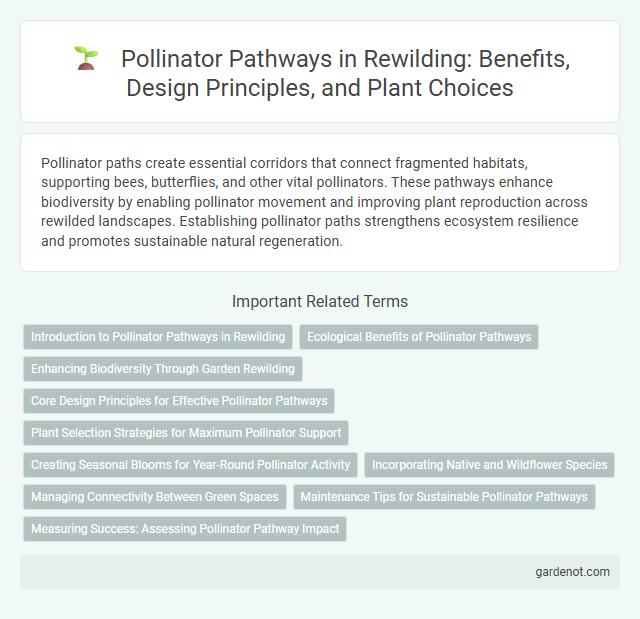Pollinator paths create essential corridors that connect fragmented habitats, supporting bees, butterflies, and other vital pollinators. These pathways enhance biodiversity by enabling pollinator movement and improving plant reproduction across rewilded landscapes. Establishing pollinator paths strengthens ecosystem resilience and promotes sustainable natural regeneration.
Introduction to Pollinator Pathways in Rewilding
Pollinator pathways are essential ecological corridors designed to reconnect fragmented habitats, enabling the movement and survival of pollinating species such as bees, butterflies, and hummingbirds. These pathways increase biodiversity by supporting critical pollination services necessary for plant reproduction, ecosystem resilience, and food security. Integrating pollinator-friendly plants and native flora along urban and rural landscapes enhances habitat connectivity, promoting healthy pollinator populations within rewilding initiatives.
Ecological Benefits of Pollinator Pathways
Pollinator pathways create continuous habitats that support diverse pollinator species, enhancing biodiversity and ecosystem resilience. These pathways improve pollination services for wild plants and agricultural crops, boosting food production and plant genetic diversity. Establishing pollinator corridors also strengthens ecological networks, facilitating species migration and adaptation amid climate change.
Enhancing Biodiversity Through Garden Rewilding
Pollinator paths serve as vital corridors that connect fragmented habitats, boosting biodiversity by supporting essential pollinator species such as bees, butterflies, and native beetles. Garden rewilding transforms traditional lawns into rich ecosystems filled with native wildflowers and shrubs, which provide food sources and nesting sites while enhancing ecological resilience. These interconnected green spaces promote plant-pollinator interactions that sustain local flora diversity and contribute to broader environmental restoration efforts.
Core Design Principles for Effective Pollinator Pathways
Pollinator pathways are most effective when designed around core principles such as habitat connectivity, native plant diversity, and continuous bloom sequences throughout the growing season. Prioritizing locally adapted flowering plants supports native bee populations and enhances overall ecosystem resilience. Creating layered vegetation structures ensures resources for various pollinator species, promoting biodiversity and ecosystem services.
Plant Selection Strategies for Maximum Pollinator Support
Selecting a diverse array of native flowering plants with staggered bloom times ensures continuous nectar and pollen availability throughout the growing season, maximizing pollinator support. Incorporating species from multiple plant families attracts a wider variety of pollinators, including bees, butterflies, and hummingbirds, enhancing ecosystem resilience. Prioritizing nectar-rich and host plants tailored to regional pollinator species optimizes habitat restoration efforts within rewilding projects.
Creating Seasonal Blooms for Year-Round Pollinator Activity
Creating seasonal blooms through diverse native plant species ensures continuous nectar and pollen availability, supporting year-round pollinator activity such as bees, butterflies, and hummingbirds. Designing pollinator paths with early spring crocuses, summer milkweed, and late autumn goldenrod maximizes habitat connectivity and enhances biodiversity. This approach strengthens pollination networks, contributing to ecosystem resilience and successful rewilding initiatives.
Incorporating Native and Wildflower Species
Incorporating native and wildflower species into pollinator paths enhances biodiversity by providing essential nectar and habitat for bees, butterflies, and other pollinators. Native plants are adapted to local soil and climate conditions, ensuring better growth and sustainability while supporting the life cycles of indigenous pollinator species. Establishing diverse wildflower arrays boosts ecosystem resilience and promotes natural rewilding processes, leading to healthier pollinator populations.
Managing Connectivity Between Green Spaces
Pollinator paths enhance biodiversity by creating corridors that connect fragmented green spaces, allowing bees, butterflies, and other pollinators to move freely and access diverse floral resources. Effective management includes strategic planting of native flowering species along these corridors to ensure continuous nectar and pollen availability throughout the growing season. Maintaining connectivity between urban parks, community gardens, and natural reserves supports ecosystem resilience and promotes healthy pollinator populations vital for plant reproduction and food security.
Maintenance Tips for Sustainable Pollinator Pathways
Regularly monitor and remove invasive plant species to ensure native pollinators have access to their preferred flora along the pollinator path. Use organic mulch and avoid chemical pesticides to preserve soil health and protect bee populations. Maintain diverse plantings with staggered bloom times to support pollinator activity throughout the growing season.
Measuring Success: Assessing Pollinator Pathway Impact
Evaluating the effectiveness of pollinator pathways involves monitoring pollinator abundance, diversity, and behavior within restored habitats. Data on species richness and visitation rates provide key indicators of ecosystem health and pollination services. Long-term assessments using standardized protocols ensure adaptive management and enhanced biodiversity outcomes.
Pollinator path Infographic

 gardenot.com
gardenot.com